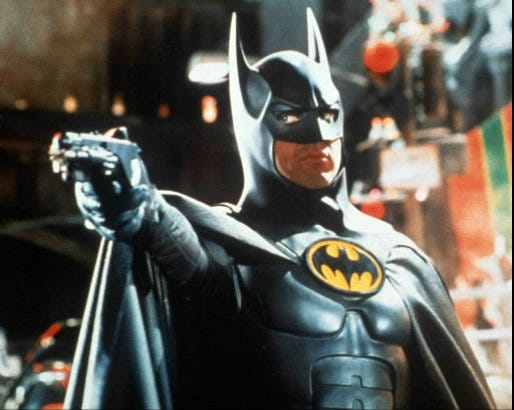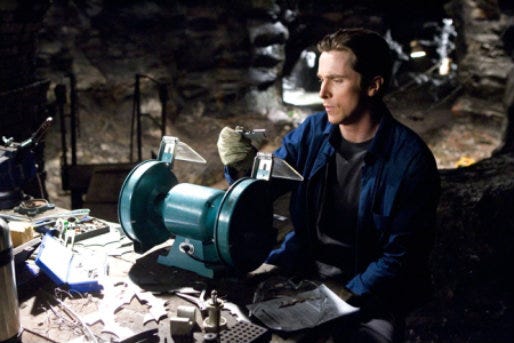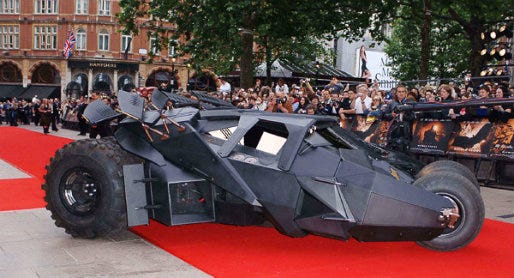Reinventing Batman: Part One
Early Batman

Tim Burton took the reins from the 1960s camp TV show and transferred the character to the big screen with his 1989 blockbuster hit “Batman." His Bat superhero was much darker and had an edge of dangerousness compared to Adam West’s portrayal in the TV series. It was more akin to Frank Miller’s darker series of Batman comics, “The Dark Knight." Burton’s heavy gothic themes, though impressive, keep the character and Batman universe in the area of whimsy and remain, until a few years ago, still a sort of joke. Cinematically speaking, his and Joel Schumacher's subsequent films, were more for the masses. However, Burton’s darker vision is still praised today and his Batman, Michael Keaton (1988's “Beetlejuice”), is seen as the best among him, Val Kilmer (2005's “Kiss Kiss Bang Bang”) and George Clooney (2010's "The American").
Director Christopher Nolan

No one really wanted to touch the Batman franchise again after the barrage of abuse aimed at the last Batman film, “Batman and Robin” (1997). Since then, studios have tried many times to regenerate the Batman franchise. Finally, keeping a tight lid on the project, indie-cult director Christopher Nolan was hired by Warner Brothers on a new Batman project. With him at the helm, it was fair to say that this was going to be a very new and different approach to the superhero. Fearful of anything leaking onto the Internet, meetings about the new Batman film were held in top secret at his house. Nolan says he was influenced by the Superman franchise, in particular Richard Donner’s 1978 film that explores the origins — something he felt hadn’t been covered before for Batman. He was also aiming for a darker and more realistic tone and wanted to use as little CGI as possible, preferring grand-scale sets, up-to-date costumes and sleek gadgets.
Batman Begins

Nolan and his co-screenwriter David S. Goyer go behind the mask, uncovering the mystery of Bruce Wayne and his transformation into Batman. The relationship between superhero and society and how society views the superhero/vigilante type is explored.
We go right back to when young Bruce first discovered the bat cave underneath his parents' sprawling mansion and the circumstances of his parents' death. Scenes before the tragedy seem almost bathed in light and warmth, then everything after is muted in shades of blue and black. Years later their killer Joe Chill (Richard Brake, 2007's “Hannibal Rising”) is murdered by crime boss Falcone’s assassins for testifying against him, robbing Wayne of his chance of revenge. This sparks a quest to learn of the criminal underworld, leading him to the harshness of a Bhutanese prison and then training with the League of Shadows under Ducard (Liam Neeson of 2008's “Taken”).
Wayne returns to Gotham City, reintegrating himself to society and creating his alter ego in secret — a hero who lives in shadows, creating fear in his enemies. Fear and guilt are big themes for Wayne and Nolan’s film in general. Wayne utilizes the bat symbol, a representation of his own fears, as it was this fear that led his parents out into the alley the night of their death. He feels incredible guilt over this and being unable to exact his vengeance, which becomes a motivator for him. Fear is also a very modern theme that resonates with the audience — fear of terrorism, of being afraid to go about daily life, and also fear of the corrupt government.
Bruce sees that his family was failed by the system when Joe Chill was allowed parole for testifying against Falcone. The people of Gotham (the cityscapes are a mix of real ones such as Chicago and New York, making Gotham more real for the audience) live in fear every day, not only from the sheer number of criminals and high crime rate but also because of the corruption in the city’s government — the people they should trust to protect them. Wayne/Batman is a crimefighter, but he is also in conflict within himself. Christian Bale’s Batman is clearly influenced by his previous roles as the very dark and monstrous Patrick Bateman in 2000's “American Psycho” and the realistically pained Trevor Reznik in “The Machinist” (2004). In the end, his devotion to Gotham (something he shares with his father) and its people brings hope for them and the possibility of an end to the hold criminals and the corrupt have.
The After Effect

What a difference a few years make. We couldn’t be further from Schumacher’s trashiness and the camp TV show. The Penguin and the Riddler would look seriously out of place and out of their league in Batman’s modern city. Here we have a true vigilante for modern times, fighting back against the criminal underworld with all the swanky gadgetry money can buy. He’s saved the city and given hope back to its residents. Four and five stars are the average rating for the regenerated Batman film, the critics studios feared the most are satisfied and the crew can breathe a sigh of relief. The next challenge: the sequels.


